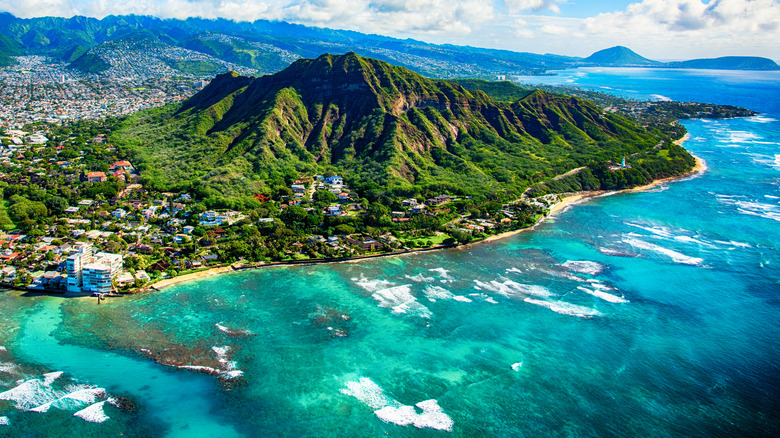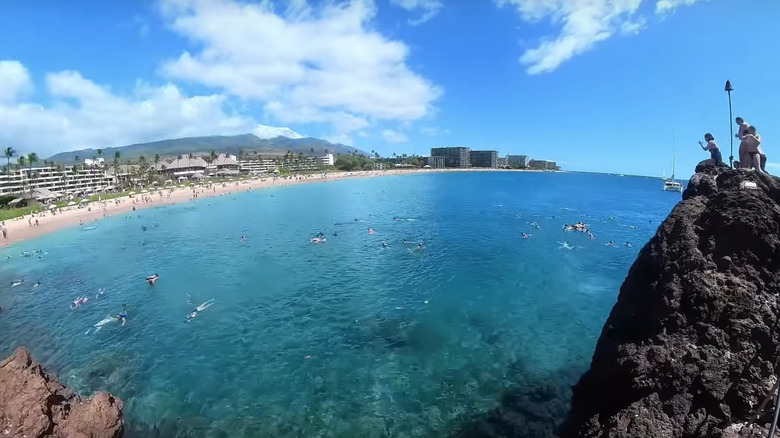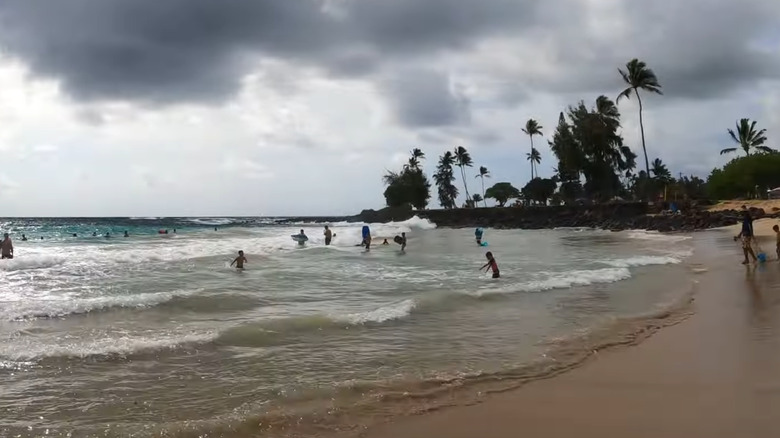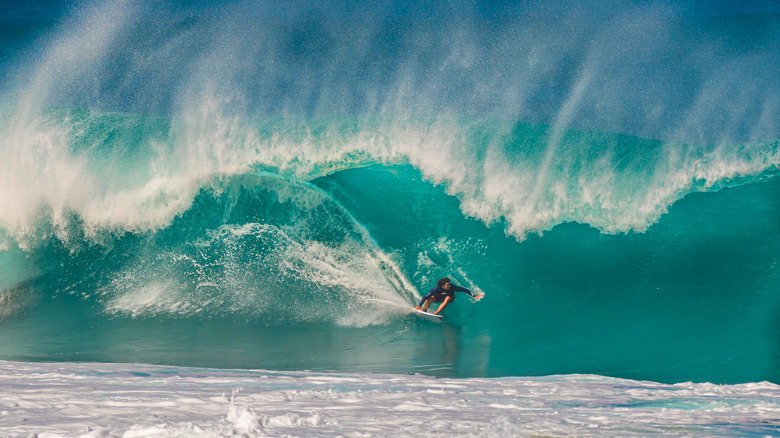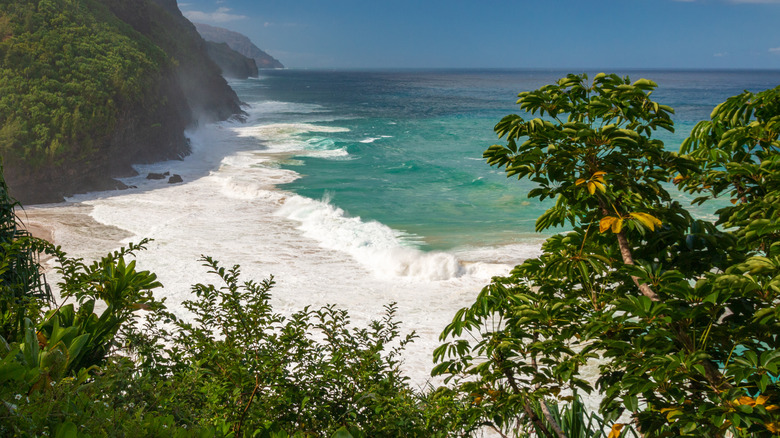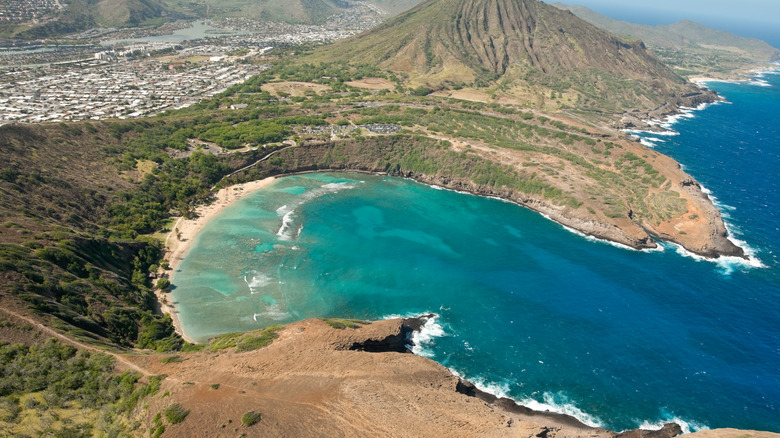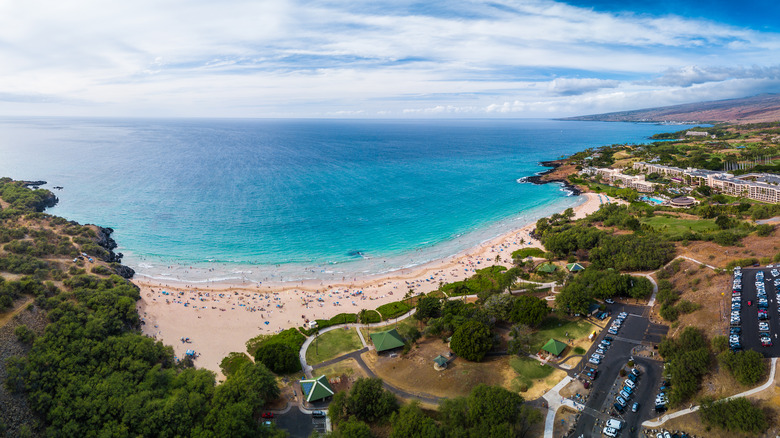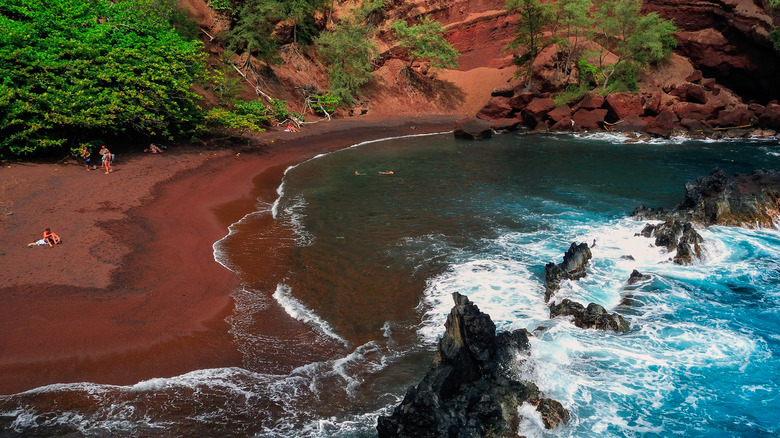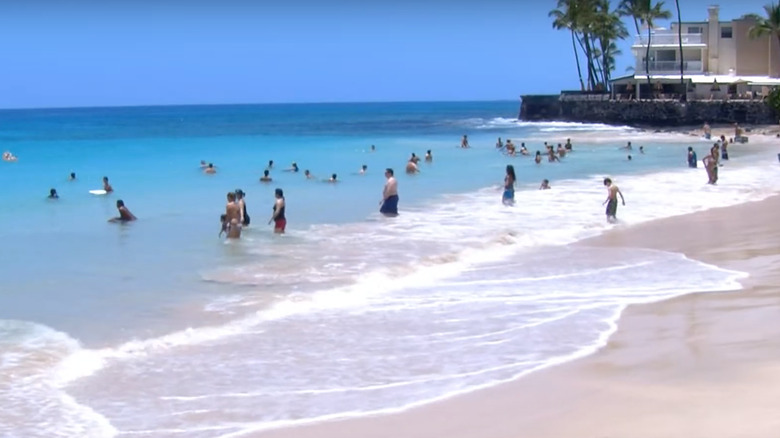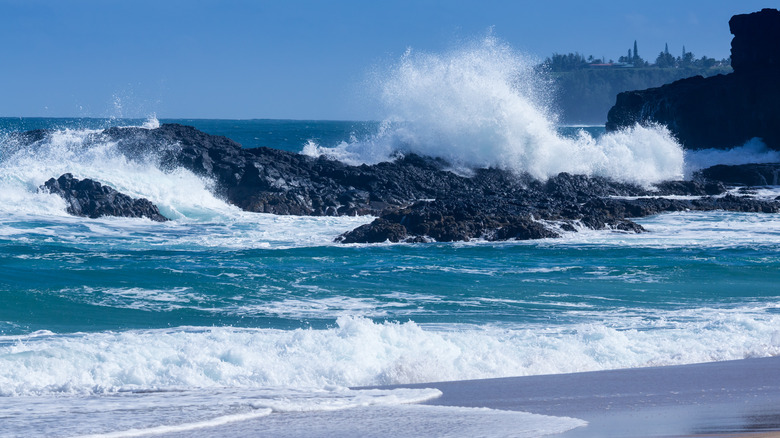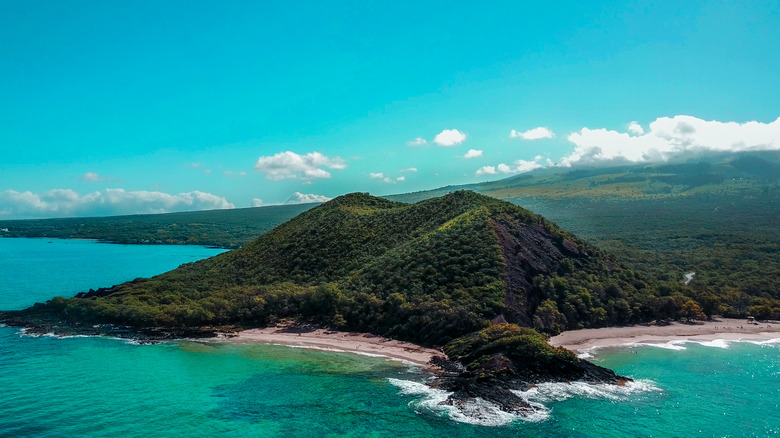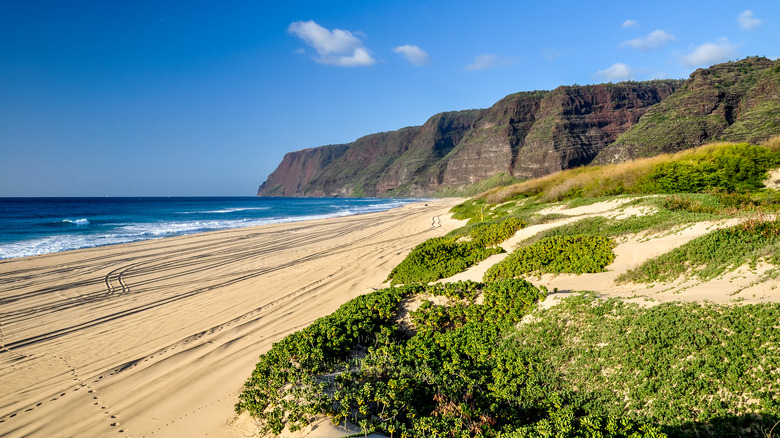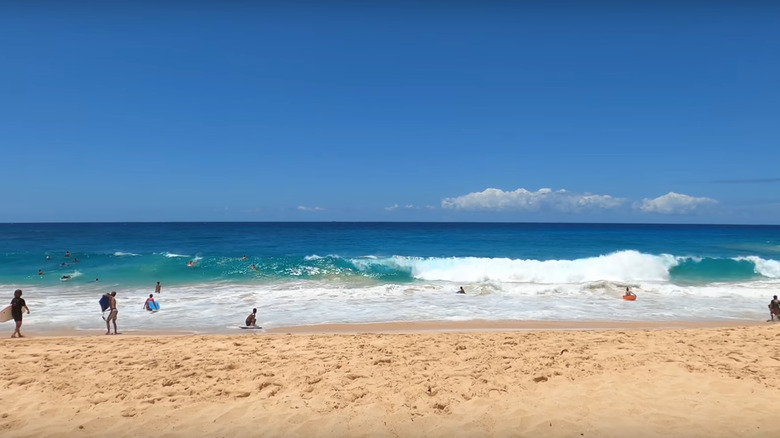Beautiful Beaches In Hawaii That Are Too Dangerous For Swimming
The island state of Hawaii is thousands of miles from the mainland U.S., and this remoteness is part of its appeal. For starters, the terrain and geography are so different from anything in the Lower 48 and Alaska, that vacationers prize its dissimilarity. Yet it's as easily visited as a domestic destination, without travelers needing to worry about customs, visas, or even passports, and this tropical paradise welcomed more than 9 million visitors in 2022. Hawaii has some of the most spellbinding scenery on the planet, with soaring volcanic peaks, sheer cliffs that drop into the ocean, lush jungles with waterfalls galore, and miles and miles of mind-blowing coastline.
Many visitors come here expressly to experience nature in all its glory, to try some of the various activities, or spend time lazing on the islands' many sumptuous beaches, of which there are plenty. And yet, while all of the beaches are ideal for a bit of sunbathing, not all are suited to the joyous pastime of swimming. Hawaii sits moored in the middle of the South Pacific, and while some parts of the islands are protected from the ocean's incredible power, others feel the full brunt of it. The waves, for those in the surfing community, in Hawaii are legendary, but so, also, are the related dangers. A number of beaches around Hawaii might look gorgeous from above, but beware, their shallow (and deep) waters are rarely still, making them treacherous to enter. Here are some swimmers should avoid.
Black Rock
This beach is easy to spot when you consider its name — it is located at the northern tip of Ka'anapali Beach on Maui and is where a finger of black rock that was once molten lava juts out toward the ocean. Ka'anapali Beach itself is a hugely popular destination, with miles of soft sand ceding to the blues of the Pacific, and a number of grand properties lining its waterfront, but for thrill seekers, Black Rock is an especially magnetic place to be. From up on the jagged promontory, adventurers clamber up to the small cliff to leap into the wild blue yonder, and there is even a nightly cliff-jumping ceremony there all year round to commemorate an old Hawaiian legend.
There's also some great snorkeling there, with fish teeming offshore and turtles often frequenting this part of the coast. To the naked eye, the water around Black Rock Beach might seem very calm, but the currents are strong, and incredibly deceptive, making this a waterscape that can easily catch bathers unaware and pull them out into the depths that lie a short distance away. There are also no lifeguards on duty at this beach. The rock's name in Hawaiian is Pu'u Keka'a, and native legend considers it a place where the spirits of the deceased leaped off this mortal coil to be united with their forebears.
Brennecke's Beach
Kauai's pristine wilderness has long excited visitors to Hawaii. Among the highlights of this island is Poipu Beach Park, one of the Top 10 beaches of 2023 according to Dr. Beach, notable as much for its silky sands as for its excellent snorkeling. Just a couple of minutes walk away, Brennecke's Beach is a much smaller stretch of sand, and at some periods of the year, has water that is as calm as a bathtub. But often, the waves here are much more savage than at Poipu Beach, and with no lifeguards on duty, and with its sides blanketed by rock formations, Brennecke's is a much less forgiving piece of coastline.
The middle of the beach, where the water funnels in before heading back out, is prone to rip currents, and combined with strong surges that can smash against the lava rocks along the beach edges, this is not a beach for novices. It does, however, attract boogie boarders and body surfers that use the power of the water to their advantage, as well as swimmers and snorkelers that are comfortable dealing with wavy, turbulent conditions.
'Ehukai Beach Park
Surfers might know this beach on the North Shore of Oahu by the name Banzai Pipeline, a spot revered among wave-riders for its consistent barrels that roll toward the shore. This kinetic activity is why the destination is popular with surfers and bodyboarders. This is also where globally renowned surfing competitions are hosted each winter, including the Billabong Pipeline Masters, part of the Vans Triple Crown of Surfing that draws the world's elite surfers each winter.
During the summer, as is the case with many beaches across Hawaii, the water is much more placid, and the wave-riding crowd thins out a little, but the ocean is still to be treated with vigilance. What makes the waves here such a force is intimately connected to physics; these might not be the most towering planes of water on the planet, but as they travel across the ocean, generating force along the way, they build irresistible momentum. When the ridge of water confronts the reef that sits close to the shore here, the waves rise quickly and suddenly, and that speed, coupled with a jagged reef, together make this a waterway that novices should avoid.
Hanakapiai Beach
One of the most beautiful hikes anywhere in the United States, the Kalalu Trail extends over 11 miles of Kauai terrain, shuttling between Ke'e Beach and Kalalau Beach along the Na Pali Coast. The track will take visitors up and down valleys on its route, rumble along sea cliffs, and brings into sharp view the rugged, striking waterfront topography. One of the stops along the way is Hanakapiai Beach, another gorgeous section of sand that is a dream to look at, but a demon to enter.
The water is merciless, powerful, and churning, and no swimmer is a match for its primal force. While many beaches around Hawaii are buffered from the full force of the ocean by offshore reefs, there is no such barrier here, making the beach bear the brunt of any swells that roll in. The variation of the water here is so stark that the sand on the beach is only visible during the summer, with winter making it disappear under raging high tides. Not only are the waves forceful, but the currents below them, which aren't as obvious to the naked eye, are strong enough to yank bodies far away from the shore.
Hanauma Bay
There is no doubt that this bay is a great place to snorkel, and hundreds of thousands of visitors go there each year to paddle and kick in the clear blue waters without any consequences. And yet, as with any foray into open water, visitors that swim here need to do so with caution, since the bay is not immune to strong currents. Hanauma Bay has plenty of small sections, with patches of corals, channels between them, and other parts that make up this large bay, and this variety might be a boon for an inquisitive visitor, but it's also a fertile breeding ground for water currents that aren't immediately evident.
The bay is extremely popular as a place of natural beauty, with a location close to the city of Honolulu, on the island of Oahu, adding to its appeal, but drownings here are not unheard of. Swimmers, therefore, should navigate with utmost care if they chose to brave the waters to enjoy some of the state's finest snorkeling.
Hapuna Beach
On the northwest coast of the Big Island, the largest isle in the Hawaiian archipelago, this stretch of sand that is part of the Hapuna Beach State Recreation Area is sure easy on the eye. For parts of the year, the water is calm and clear, the type of paradisiacal seaside that lures holidaymakers to Hawaii in the first place. But looks can be deceiving, and for the six months of the year, from the middle of fall to the beginning of spring, the surf really kicks up. This is also when rip currents are rampant, and combined with waves that are three feet high or more, packed with power and unstoppable in their might, swimmers should avoid the ocean during this part of the year.
These conditions, however, don't deter body surfers and others accustomed to tackling the rough seas. The park itself is a great place to visit, with hiking trails that shadow the coastline, and even basic A-frame refuges that visitors can sleep in overnight, though bookings are required. At the beginning of each year, whales sometimes make their presence felt by breaching as they glide through the waters in the distance.
Kaihalulu Beach
Known also as Red Sand Beach, this cove on the eastern edge of Maui is so pretty and picturesque that it's worth a visit just to see the rust-colored sand and rocks contrasting with the frothy blue seas. The way that the water swirls in different directions, hitting rocks that sit offshore, sometimes crashing over them before heading further in toward land, gives travelers a hint of the dangers of the ocean there. The water, in shades of the kind of deep blue that one often relates to deep ocean, has currents that are capricious and potent, making a swim off the beach a dicey proposition.
What's more, getting here isn't as simple as parking nearby and talking a leisurely stroll to the water's edge. A reason that the beach is extra special is its lack of access, requiring a hike along slippery terrain where one misstep can easily lead to a bad injury, and though the walk isn't long in terms of distance, it's another hazard to contend with. The view, once you get here, is spectacular though, with the russet hues coming from the cinder cone volcano of Ka'uiki Head which sits just above the curling beach.
La'aola Bay Beach Park
A compact beach on the west coast of the Big Island, this spread is more readily known by the name Magic Sands, or also Disappearing Sands. That label refers to the way that this coastline changes at various points of the year — in the winter, the brilliant white sand disappears, sucked away by the strong breaks and pounding surf, exposing the waterfront as a shoreline populated by rocks. Yes, this is a good place to frolic in the water during the summer, when conditions tend to be calmer and more predictable, but even then, the vagaries of the tide and episodes of powerful surf sometimes make the sand vanish before returning again.
The summer sees sunbathers and snorkelers arriving here early in the mornings for a day of fun in the sun, but come winter, the beach becomes the realm of experienced surfers and boarders; novices are in short supply then, even if lifeguards stay on duty all year round. Even when the surf isn't that powerful, the shore break can be deceptively strong, which is why regulars are always scanning the ocean so as not to be caught unawares.
Lumahai Beach
Hawaiians might not be known for their somber use of wordplay, but one might not believe that assertion upon hearing the nickname of this beach on Kauai. It's sometimes referred to as "Luma-die," a moniker that makes no bones about the danger of swimming here — the super-powerful undertow at this beach can drag bathers into the ocean, never to return. The sand here sure is inviting, soft, sugary, and pleasant to dig your toes into, but what makes it treacherous is the way that is steeply drops off when in the water, generating the perfect conditions for an undertow that is as merciless as an accomplished assassin.
Unlike waves which tend to push bathers in a lateral direction (unless they get caught under a cresting one), undertows are a current underneath the surface created when waves break on the shoreline. These strong currents can pull swimmers out into the ocean, often leaving them completely discombobulated and confused as to which way is up or down. Yet the undertow isn't the only peril here, and powerful breaks by the shore have enough force to knock beachgoers off their feet, and ferry them back out to the ocean when the water retreats back to its depths.
Makena State Park
Unlike some of the more commercial beaches along the coasts of Hawaii's islands, the beaches at this Maui getaway are blissfully wild and devoid of a scintilla of commercialism. Strolling along the two ribbons of sand — Little Beach and the much longer Big Beach, separated by a headland of black lava rock that must be climbed with great care — is a restorative excursion into the beauty of Mother Nature. The water is also joyously clear here, a shade of turquoise that eventually bleeds into a much deeper blue a short distance offshore. But don't be fooled by the utopian tableau, this beach has some foreboding undercurrents.
According to statistics from the State of Hawaii's Department of Health Neurotrama Program, there were 28 incidences of spinal-cord injuries in the waters here from 2012 to 2016 (second only to 31 at Hapuna Beach). The culprit is the strong shore break, a surging torrent of water that can destabilize even the most sure-footed beachgoer — the Hawaii government's Division of State Parks page on this park even has a strongly worded warning that states "CAUTION: Shore break can be very dangerous!" That said, the beach is definitely worth a visit, stunning and untamed, with a volcanic cone rising above it — the peak of Pu'u Ola'i — and views of nearby islands in the distance.
Polihale State Park
Wild nature at its consummate best awaits the intrepid traveler at this beach on the west coast of Kauai. There are no facilities here, but this might be the least of your concerns, since getting to this beach requires considerable effort. The route that winds its way to the waterfront there is little more than a dirt road, one that during intense rains is prone to heavy flooding, rendering it impossible to pass. Visitors will need a four-wheel drive vehicle to get here, though some rental four-wheel drives might even be banned from using this road — travelers should check with their car rental firm before attempting the trip.
The beach itself is like a breath of fresh air, sculpted by the elements with grand dunes that swoop down to the sandy shoreline. In summer, swimming there can be immensely fulfilling, but beachgoers should still beware of the currents, both general ones in the water and rip currents that have the power to pull a swimmer far out to sea.
Sandy Beach
Another Oahu beach that's easily reached from Honolulu, and that sits a short distance northeast of Hanauma Bay, this destination has a nickname that should serve as a warning to newcomers — locals sometimes call it "Broke Neck Beach." The waves here are extremely powerful, and should not be underestimated, constantly smashing against the shore with a thunderous boom as they break. This is why bodysurfers and bodyboarders are in such high supply here, riding the swells back to the shore.
Red flags are often hoisted in the sand by this beach to relay the danger of the conditions to anyone lounging on the sand, and waves do roll in here throughout the year, even in the calmer summer months. Adding to this cocktail of calamity, the coral under the surface is abundant and sharp, and there are currents that are impossible for a human to overcome, however strong a swimmer they are. The beach, with little shade and basic facilities, is great for sunbathing though, just don't get into the water.
